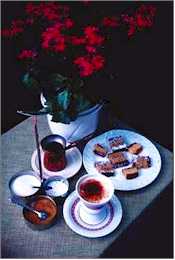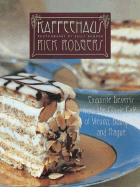Recipe of the Day Categories:
 Recipe Home Recipe Home
 Recipe Index
Recipe Index
 Recipe Search
Recipe Search
 Appetizers Appetizers
 Beef
Beef
 Beverage
Beverage
 Bread Bread
 Breakfast Breakfast
 Cake Cake
 Chocolate Chocolate
 Cookies Cookies
 Fish Fish
 Fruit Fruit
 Main Dish
Main Dish
 Pasta Pasta
 Pies Pies
 Pork Pork
 Poultry Poultry
 Salad Salad
 Seafood Seafood
 Side Dish Side Dish
 Soup Soup
 Vegetable Vegetable
 Surprise! Surprise!
![[Flag Campaign icon]](http://a1032.g.akamai.net/f/1032/81/30m/www.gamesville.lycos.com/art_gv/ribbon_small.gif)

Typical Austrian coffee service
(photo courtesy europeforvisitors.com)

Cafe Corzo Violin...
Buy This at Allposters.com

The Cafe
Tsuguharu ...
Buy This at Allposters.com

 In the Cafe
In the Cafe
Giclee Print
Herremans, Lieven
Buy at AllPosters.com

Budapest
Polya Tibor
Buy This at Allposters.com

Shop igourmet.com
|
|
Your
patronage of our affiliate
partners supports this web site.
We thank you! In other words, please shop at LBC
Gift Galerie!

Cafe Griensteidl, Vienna, 1890
Reinhold Volkel
Buy This at Allposters.com

La Belle Cuisine
"Through his collection of outstanding recipes,
evocative vignettes, splendid photographs, and a wealth of historical
information and anecdotes, Rick
Rodgers brings to life the glories of the
Austro-Hungarian Kaffeehaus and
it rich culture.
At last, the legendary
pastries of Vienna, Budapest and
Prague are given the attention they
deserve."
~ Dorie Greenspan, author of Baking
with Julia
 
KaffeeHaus:
Exquisite Desserts
from the Classic Cafes of
Vienna, Budapest, and Prague

by Rick Rodgers, 2002, Clarkson Potter
  The most
challenging aspect of writing this feature for you is choosing which
commentary and recipes to present. This is a marvelous book! It seems a
shame
not to be able to just sit down with you and show you exactly how
marvelous. Obviously, I can offer you only the tip of the iceberg here.
Recognizing that,
perhaps it would be best to rely on the publisher’s
expertise to make the introduction, lest I get carried away…
“At
Sacher, Demel, Gerbeaud, and other legendary cafes of Vienna, Budapest, and
Prague, a rich tapestry of culture is still celebrated, and not just through
the dark brew served on a silver tray but in exquisite, masterful desserts.
Writers, painters, philosophers, and poets have gathered for centuries
around Kaffeehaus tables, in lively conversation, sampling desserts that
have set these institutions apart from their counterparts throughout the
world…
In Kaffeehaus, author Rick Rodgers has collected the best classic
Austro-Hungarian pastries, and expertly shows how to create these glorious
treats in
your own home. Using his celebrated skill as a teacher to present
the recipes to bakers of all levels, Rodgers complements the fare with
astute observations of Kaffeehaus culture and its three-hundred-year-old
traditions, customs so entrenched they are almost choreographed…
No matter the country, ‘rich’ and ‘sweet’ translate into any language, and
Kaffeehaus beautifully captures the tastes and the elegance of these cafes,
commemorating their culture and history and the delectable legacy of their
desserts.”
All I can
say to that is, “Amen!”
Europeans
take their coffeehouses very seriously. My personal Kaffeehaus experience is
limited to Germany, Austria, France, Belgium and Switzerland
but
I daresay
that if I singled out a handful of countries I would be in trouble.
So.
We
shall just say European, which seems to be a sign of the times anyway.
How
serious are the Viennese? This serious:
When a Coffeehouse Is
Not a Coffeehouse
“Not every place that serves
coffee is a coffeehouse. In Vienna, coffeehouses
are strictly licensed
according to what they serve, although there is some
blurring
of boundaries.
In 1999, there were 2,635 Viennese ‘coffeehouses’ in operation in six
categories
[as opposed to 11 in operation in 1729]:
-
564 Kaffeehaeuser
(coffeehouses), safes with seating serving only cold food, especially
desserts, which may or may not be baked on the premises. Typical
coffeehouse cold plates include sausages and cheese platters.
-
611 Kaffee-Restaurants
(café-restaurants), establishments that serve hot food as well as cold.
The exact menu varies, but you can usually dig into a bowl of goulash, and
hot sandwiches are very popular.
-
911 Espressos, places serving a
quick cup of espresso. They usually don’t serve liquor, pastry, or food –
just espresso, and no other coffee-based beverages. There may be a few
stools and counters for basic seating.
-
133 Kaffee-Konditoreien
(café-bakeries), which are full-scale bakeries with seating. Some of the
most famous names in Viennese pastry, such as Demel, Oberlaa, Heiner,
Gerstner, and Lehmann, are actually Konditoreien and not coffeehouses.
Even though both words can be translated as ‘bakery’, Konditorei is
different from Baeckerei. A Konditorei specializes in sweet baked goods
(not necessarily made with yeast) and confections, but a Baeckerei
produces yeasted baked goods, especially the household daily bread. A
Kurkonditorei is a bakery that has set very high standards.
-
35 Stehkaffee (‘standing
coffee’), a stall serving coffee and rolls, found at train stations and
the like.
-
The balance consisted of 381
Nichtbetriebe, places that were holding
licenses but not using them.
These figures are very revealing.
For all of the nervousness concerning the rise of the impersonal espresso
bar, if the figures for classic establishments are added up (including
coffeehouses, café-restaurants, and bakeries with seating), they prove that
the traditional settings remain to serve their customers in style.”
Wonderful. Interesting, to be sure.
But where are the RECIPES? Coming right up, folks. Just a bit more
background. As Rick Rodgers says, “Coffee’s origins are appropriately dark
and murky.” We won’t go there. Highlights only. Okay? And
why don’t you
freshen up your coffee in the meantime…
-
1554 – The first coffeehouse
opened in Constantinople. [Istanbul]
-
Late 1500s – Coffee began making
appearances in Europe.
-
1598 – Pope Clement III sipped
his first cup of coffee and
proclaimed
it ‘a truly Christian beverage’.
-
[circa] 1645 – Venice
-
1652 – London (“A few years
later, Edward Lloyd opened a café
where he printed a newsletter with
shipping industry news. This
practice was the start of Lloyd’s of London
insurance company.”
-
1671 – Hamburg
-
1672 – Paris
But what
about Vienna? There is a very interesting story/legend here having to
do
with "the terrible 1683 siege of Vienna", a Polish war hero called Georg
Franz Kolschitzky and his establishment of the first Viennese coffee
business. History shows, however, that as early as 1665 the Turkish Grand
Ambassador "had planted the seeds for Vienna's love affair with coffee" by
serving both brewed coffee and coffee sherbet in the salon of his embassy.
Let us just say that coffee has had a loyal following in Vienna for a very
long time.
Okay. Bring
on the recipes! We shall begin with a very famous and beloved Viennese
Kaffeehaus beverage:
Hot Coffee with Orange Liqueur
Maria Theresia
Makes 1
serving
“Any
time a food is named for the beloved empress Maria Theresia, you can be
sure
it includes the most refined blend of ingredients. (Chicken Maria Theresia
has poached chicken breasts with sliced ox tongue masked with a creamy
poultry
sauce – over the top to some tastes, but the height of luxury
cooking in earlier
times.) You’ll find this hot coffee drink on almost every
Viennese coffeehouse
menu. It’s often made with a clear orange liqueur like
Triple Sec or Curaçao,
but Cognac-based Grand Marnier stands up to the
strong coffee with more
authority. By substituting rum for the orange
liqueur, you’ll get a Fiaker,
named for the horse-carriage drivers, who
needed something warming to keep
themselves going. Fiaker is traditionally
served in a glass with a handle, as
carriage drivers would need to keep one
hand free for holding the reins.”
Boiling water, for heating the glass
3 tablespoons orange-flavored liqueur, such as Grand Marnier
1 teaspoon superfine sugar
1 cup hot, brewed coffee, preferably Vienna roast
A dollop of Sweetened Whipped Cream (recipe follows)
Freshly grated orange zest, to taste, for garnish
Fill a coffee cup with boiling water and let stand for 1
minute to heat
the glass. Pour out the water. Pour the liqueur into the cup
and stir in
the sugar. Add the coffee. Top with the whipped cream, then
grate
the orange zest over the top. Serve immediately.
Fiaker
Substitute golden rum for the liqueur, and omit the orange
zest.
Sweetened Whipped Cream
Schlagobers
Makes 2 cups
“Throughout the rest of the German-speaking world, whipped cream is called
Schlagsahne, but the Viennese call it Schlagobers, which translates into
some-thing like ‘very-well whipped’. Whipped cream is a very important
ingredient
in the daily life of a Viennese; a dab goes on top of coffee or
tea, or alongside
the afternoon snack, or, unsweetened, as a garnish for
soup.
First, use high-quality cream (pasteurized, rather than ultra-pasteurized)
with
a high butterfat content (36 to 40 percent), which whips up thick and
fluffy and
has better flavor. Your natural food stores might carry such a
cream, or look at
old-fashioned dairies.
Room-temperature cream won’t incorporate air, so use well-chilled cream
straight from the refrigerator. Use a chilled metal bowl or place the bowl
in a larger bowl of iced water.
For sweetening, confectioners’ sugar is preferred to granulated sugar
because
the small amount of cornstarch in the former discourages the weeping
that
occurs when whipped cream stands for longer than a few hours. A hint of
vanilla is imperative.
Learn to distinguish between the stages of whipped cream; it doesn’t always
have to be stiff. As a garnish for a dessert, the goal is softly beaten Schlagobers
that barely mounds. When used for piping, cream should be
whipped to the stiff
stage. Of course there is an in-between stage, too,
used for when cream is the
base for a torte filling. Take care not to overwhip the cream, at which point it
has a coarse, grainy texture and is
well on its way to becoming butter.
A balloon whisk will give you the most control over the whipping process,
but
most people prefer an electric mixer. A hand mixer is best, because the
strong
motor of a standing mixer makes it difficult to gauge the whipping
progress
and can quickly overwhip the cream.”
1 cup heavy cream
2 tablespoons confectioners’ sugar
1/2 teaspoon vanilla extract
Pour the cream into a well-chilled bowl and
add the sugar and vanilla. Using an electric hand mixer or balloon whisk,
beat the cream to the desired consistency. For soft peaks, the cream will be
just thick enough to hold its shape in soft billows. For stiffly beaten
cream, the beaters or whisk wires will leave distinct traces in the cream
and stand in firm peaks when the beaters are lifted.
Make ahead:
The cream can be whipped up to 1 day ahead, covered tightly with plastic
wrap, and refrigerated. If liquid separated from the cream, whip it again to
incorporate the liquid.
More
Kaffeehaus - Sachertorte!
Nothing bad could ever
happen to me in a café...
Cafe de la Belle
Cuisine
Featured Archive Recipes:
Viennese
Coffee Menu
Crazy for Coffee
Coffee
Collection
Index
- Cookbook Features
Index - Beverage
Recipe Archives
Daily
Recipe Index
Recipe Archives Index
Recipe Search |











